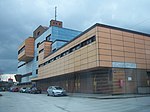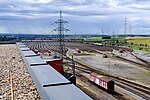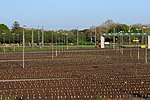Central marshalling yard Wien-Kledering
The central marshalling yard Wien-Kledering (Wien Zvbf) is the largest marshalling yard in Austria .
location
The marshalling yard is located in the 10th Viennese district of Favoriten on the southeastern city limits of Vienna , as well as in the cadastral municipality of Kledering, which belongs to the city of Schwechat ( Lower Austria ), and it borders on the 11th district of Simmering .
On the rail side, the central marshalling yard is parallel to the Ostbahn line from Vienna Central Station to Bruck an der Leitha and Budapest . A loop connects to the Donauländebahn, which runs in an east-west direction .
history
In order to remain competitive in freight transport, the ÖBB decided to implement several construction projects in the Vienna area. Since the formation of freight trains was spread over fourteen different stations, a large shunting yard was considered necessary. It was decided to go to a site in the south of Vienna. Construction began in the spring of 1978 and the first partial commissioning took place in September 1983. The 1st start-up phase took place on September 28, 1986, with the secondary rolling hill and the fine-tuning group not being put into operation until the 2nd start-up phase in January 1987. At this point in time, the number of wagons processed could also be increased from 1,840 to 2,100. The third start-up phase began in the summer of 1987, with an extension of the operating time from 16 to 21 hours and an increase in the number of cars to 2,500 per day. In December 1987 the station went into full operation without any restrictions. The cost of the station was 3.8 billion schillings .
business
The Wien-Kledering marshalling yard is operated by the Austrian Federal Railways (ÖBB). It is designed for a capacity of 6,100 wagons per day and the track length is 120 kilometers. The station has an entry group consisting of 15 tracks, a direction group consisting of 48 tracks and an exit group consisting of 10 tracks. In addition, the bypass group with 4 tracks is to the east of the direction group. The locomotive bypass track and the waiting track are located west of the direction group.
Main rolling mountain
In the direction group is the main rolling hill with a maximum gradient of 4.7 percent. It is designed for a daily output of 6,100 trolleys per day or 300 trolleys per hour. After the incoming train treatment in the approach group, the train is broken down here. Locomotives of the 1064 series take on the approach, i.e. the approach of the train to the roll-off hill at a maximum speed of 5 m / s, and the subsequent push-off at a maximum speed of 1.6 m / s. The locomotives are manned by a driver, but the approach and pull-off are remote-controlled. A slider by means of a decoupling rod ensures that the trolleys are uncoupled on the roll-off mountain.
The wagons are braked with 38,886 dowty retarders, which are divided into three zones: In the distribution zone, the response speed is 4.25 m / s, in the deceleration zone it is divided into 4 m / s, 2 m / s, 1.75 m / s and in the deceleration zone 1.5 m / s. If the cars are below this response speed, they are not braked.
Abrollberg
Side rolling hill
The secondary rolling hill, with a maximum gradient of five percent, is intended to line up the local goods trains and is designed for a mountain performance of 1,000 wagons per day. Two conventional, oil-hydraulically operated bar-type track brakes of the type "THYSSEN-TW 5" are used for speed control. The control is semi-automatic, as the speed at which the cars should leave the braking system (3 - 6 m / s) is determined by the employee at signal box 2. The braking force is set automatically by the micro-computer-controlled maneuvering system.
Others
To the south and east of the service footbridge there are two fire brigade footbridges that have been running over the tracks of the Eastern Railway and the tracks of the direction group since 1986. In contrast to the service walkway, they have no exits, but are climbed by the fire brigade with emergency ladders in the event of an emergency and primarily serve as a carrier for auxiliary equipment, hose and power supply lines. A number of the track running underneath on the outside of the footbridge is used to better localize the locations.
tasks
The central marshalling yard is only used for freight traffic. However, the freight trains are only dismantled and rebuilt, so there are no facilities for handling goods. Long-distance trains are also being formed. This also freed up capacities in other marshalling yards in Austria.
In contrast, there are freight terminals in Vienna-Inzersdorf and Vienna-Freudenau along the Donauländebahn .
literature
- Helmut Rumpold: Der Zentralverschiebebahnhof Wien , In: Eisenbahntechnik 1983/4, Bohmann Druck und Verlag Ges.mbH & Co. KG, pp. 3-11, ISSN 0013-2829
- Full commissioning of the central shunting yard in Vienna , In: Eisenbahn 1986/6, Bohmann Druck und Verlag Ges.mbH & Co. KG, pp. 101-102, ISSN 0013-2756
- A construction of the century in operation , In: ÖBB-Journal 1987/1, General Directorate of the Austrian Federal Railways
Web links
- ÖBB infrastructure operation - central shunting yard Vienna ( Memento from March 23, 2009 in the Internet Archive )
Coordinates: 48 ° 8 ′ 45 " N , 16 ° 25 ′ 45" E









